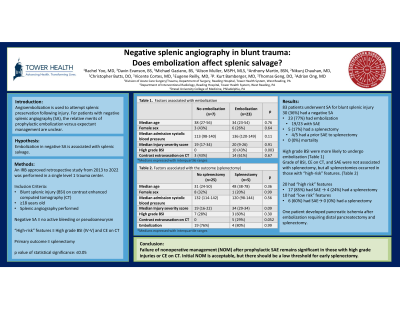Trauma
Category: Quickshot Oral Session 22
Quickshot Oral : Quickshot Oral Session 22
NEGATIVE SPLENIC ANGIOGRAPHY IN BLUNT TRAUMA: DOES EMBOLIZATION AFFECT SPLENIC SALVAGE?
Tuesday, February 14, 2023
7:00am - 8:00am East Coast USA Time


Rachel Yoo, MD (she/her/hers)
General Surgery Resident PGY2
Reading Hospital, United States- AO
Adrian Ong, MD
Trauma Surgeon
Reading Hospital, United States
Presenter(s)
Principal Contact(s)
Objectives: Angioembolization in the management of splenic trauma is an established strategy to maximize the likelihood of splenic preservation. For patients with negative splenic angiography (SA), debate exists as to whether prophylactic embolization or expectant management is the better strategy. We hypothesized that embolization in the setting of a negative SA would be associated with splenic salvage.
Methods: A retrospective study over a nine-year period (2013-2022) was performed in a single level 1 trauma center. All blunt trauma patients ≥18 years with a splenic injury found on computed tomography (CT) and who then underwent SA were identified. Those who did not have a CT with intravenous contrast were excluded. A negative SA was defined as one where there was no active bleeding or pseudoaneurysm. The decision to perform splenic embolization was made jointly by the interventional radiologist and trauma surgeon in all cases. Primary outcome was splenectomy. A p value of ≤0.05 was considered statistically significant.
Results: 83 patients underwent SA for blunt splenic injury. Of these, 30 (36%) had a negative SA. Median (interquartile range [IQR]) age was 34.5 (24-54) years and median Injury Severity Score was 20 (IQR, 16-26). 20 (66%) had a high-grade (4 or 5) injury or contrast extravasation (CE) seen on CT. Embolization was performed in 23 (77%), with main splenic artery embolization achieved in 20 of the 23. Splenectomy was performed in 5 of 30 (17%). Grade of injury (≥4 vs < 4) was not associated with splenectomy (3/10 vs 2/18, p=0.17) but CE on CT was (5/17 vs 0/13, p=0.05). Embolization was not associated with splenectomy (embolized, 4/17 vs. not embolized, 1/7, p=0.9). In the 20 patients with high grade injury or CE on CT, 17 (85%) had embolization, with a splenectomy rate of 5/20 (25%). In the 10 patients without a high-grade injury or CE, 6 (60%) had embolization, with a 0% splenectomy rate. Complications requiring intervention occurred in one patient who developed pancreatic ischemia after embolization requiring distal pancreatectomy and splenectomy.
Conclusion: Despite a negative SA, even with prophylactic embolization, the rate of failure of nonoperative management remains significant where there is a high-grade injury or CE on CT. In this high-risk cohort, initial nonoperative management is acceptable but there should be a low threshold for early splenectomy.
Methods: A retrospective study over a nine-year period (2013-2022) was performed in a single level 1 trauma center. All blunt trauma patients ≥18 years with a splenic injury found on computed tomography (CT) and who then underwent SA were identified. Those who did not have a CT with intravenous contrast were excluded. A negative SA was defined as one where there was no active bleeding or pseudoaneurysm. The decision to perform splenic embolization was made jointly by the interventional radiologist and trauma surgeon in all cases. Primary outcome was splenectomy. A p value of ≤0.05 was considered statistically significant.
Results: 83 patients underwent SA for blunt splenic injury. Of these, 30 (36%) had a negative SA. Median (interquartile range [IQR]) age was 34.5 (24-54) years and median Injury Severity Score was 20 (IQR, 16-26). 20 (66%) had a high-grade (4 or 5) injury or contrast extravasation (CE) seen on CT. Embolization was performed in 23 (77%), with main splenic artery embolization achieved in 20 of the 23. Splenectomy was performed in 5 of 30 (17%). Grade of injury (≥4 vs < 4) was not associated with splenectomy (3/10 vs 2/18, p=0.17) but CE on CT was (5/17 vs 0/13, p=0.05). Embolization was not associated with splenectomy (embolized, 4/17 vs. not embolized, 1/7, p=0.9). In the 20 patients with high grade injury or CE on CT, 17 (85%) had embolization, with a splenectomy rate of 5/20 (25%). In the 10 patients without a high-grade injury or CE, 6 (60%) had embolization, with a 0% splenectomy rate. Complications requiring intervention occurred in one patient who developed pancreatic ischemia after embolization requiring distal pancreatectomy and splenectomy.
Conclusion: Despite a negative SA, even with prophylactic embolization, the rate of failure of nonoperative management remains significant where there is a high-grade injury or CE on CT. In this high-risk cohort, initial nonoperative management is acceptable but there should be a low threshold for early splenectomy.

